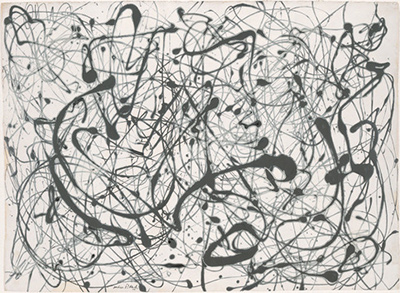Jackson Pollock's Number 14 Gray piece came to fruition in 1948 and is one of the most obvious scenes for Pollock's famous style of pouring the paint onto the canvas.
This striking example of the classic pouring technique, highlights the blacks and grays perfectly on a stark white background. Pollock dripped the enamel paint onto the surface while the gesso was still wet.
This particular method was used so that the black paint bled into the surface of the canvas and created a grey halo around the pools of black.
Number 14 Gray perfectly epitomizes Pollock's attempt to break free of the usual representational image favoured by many artists. As an inspiration to artists attempting to create new and fascinating paintings, Pollock shows with Number 14 how free movement can be created on canvas.
This work of art is certainly wild, yet still simplistic compared to other pieces by Pollock.
The deep pools of black criss-cross over with smaller dots and thin lines that swirl around the canvas. It is certainly an evocative piece considering its purity.
As one of the major figures in the abstract expressionist movement, Jackson Pollock (1912-1956) created some of the most well known pieces of drip paintings known to the art community.
Living a difficult life, Pollock struggled with depression and alcoholism, regarded as reclusive and often was described as having a volatile personality. He eventually died at the age of 44 in an alcohol related car accident.
Even though he led what could be described as a melancholy life, he still to this day is revered as one of the greatest artists of the twentieth century.




